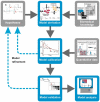Mathematical Modelling in Biomedicine: A Primer for the Curious and the Skeptic
- PMID: 33430432
- PMCID: PMC7826848
- DOI: 10.3390/ijms22020547
Mathematical Modelling in Biomedicine: A Primer for the Curious and the Skeptic
Abstract
In most disciplines of natural sciences and engineering, mathematical and computational modelling are mainstay methods which are usefulness beyond doubt. These disciplines would not have reached today's level of sophistication without an intensive use of mathematical and computational models together with quantitative data. This approach has not been followed in much of molecular biology and biomedicine, however, where qualitative descriptions are accepted as a satisfactory replacement for mathematical rigor and the use of computational models is seen by many as a fringe practice rather than as a powerful scientific method. This position disregards mathematical thinking as having contributed key discoveries in biology for more than a century, e.g., in the connection between genes, inheritance, and evolution or in the mechanisms of enzymatic catalysis. Here, we discuss the role of computational modelling in the arsenal of modern scientific methods in biomedicine. We list frequent misconceptions about mathematical modelling found among biomedical experimentalists and suggest some good practices that can help bridge the cognitive gap between modelers and experimental researchers in biomedicine. This manuscript was written with two readers in mind. Firstly, it is intended for mathematical modelers with a background in physics, mathematics, or engineering who want to jump into biomedicine. We provide them with ideas to motivate the use of mathematical modelling when discussing with experimental partners. Secondly, this is a text for biomedical researchers intrigued with utilizing mathematical modelling to investigate the pathophysiology of human diseases to improve their diagnostics and treatment.
Keywords: biomathematics; computational drug discovery; computational modelling; data-driven mathematical modelling; mathematical oncology; scientific method; systems biology.
Conflict of interest statement
The authors declare no conflict of interest.
Figures




References
-
- Ostalecki C., Lee J.-H., Dindorf J., Collenburg L., Schierer S., Simon B., Schliep S., Kremmer E., Schuler G., Baur A.S. Multiepitope tissue analysis reveals SPPL3-mediated ADAM10 activation as a key step in the transformation of melanocytes. Sci. Signal. 2017;10:eaai8288. doi: 10.1126/scisignal.aai8288. - DOI - PubMed
-
- Vescovi R., Monti M., Moratto D., Paolini L., Consoli F., Benerini L., Melocchi L., Calza S., Chiudinelli M., Rossi G., et al. Collapse of the Plasmacytoid Dendritic Cell Compartment in Advanced Cutaneous Melanomas by Components of the Tumor Cell Secretome. Cancer Immunol. Res. 2018;7:12–28. doi: 10.1158/2326-6066.CIR-18-0141. - DOI - PubMed
-
- Rosales G.S., Nikolov S., Lai X., Eberhardt M., Dreyer F.S., Paul S., Schuler G., Vera-González J. Model-based genotype-phenotype mapping used to investigate gene signatures of immune sensitivity and resistance in melanoma micrometastasis. Sci. Rep. 2016;6:24967. doi: 10.1038/srep24967. - DOI - PMC - PubMed
-
- Galilei G. Discorsi e dimostrazioni matematiche intorno a due nuove scienze. 1st ed. Einaudi; Turlin, Italy: 1638.
Publication types
MeSH terms
LinkOut - more resources
Full Text Sources
Other Literature Sources
Miscellaneous

